New Delhi: On the night of 28 August, China had attempted to move in over 1,000 soldiers to capture territory on the Indian side of the Line of Actual Control, near the southern bank of Pangong Tso, ThePrint has learnt.
However, the attempt was thwarted by a combination of an alert surveillance system and troops specialising in mountain warfare, who raced against time and managed to outflank the Chinese and dominate several heights, giving India strategic hold over Reqin Pass and Spanggur Gap in the hills in the Chushul sector.
Sources in the defence and security establishment described the Indian move as a “precautionary deployment”, and underlined repeatedly that the forces had not crossed the LAC, even though inputs said ‘Black Top’ across the LAC was also a scene of action.
ThePrint had reported earlier that Indian troops had to resort to “tactical warnings” to the incoming Chinese soldiers to dissuade them.
Also read: India is being responsible but don’t doubt our ability to defend, Rajnath tells China
How the events unfolded
Sources said at about 11 pm on 28 August, an Indian surveillance team first noticed the movement of some Chinese armoured personnel carriers (APCs) in Moldo.
This was followed by drone surveillance, and the People’s Liberation Army troops’ movement indicated they were going towards the LAC, and to a specific feature. Sources refused to identify the feature, citing operational reasons.
They said at this moment, specialised Indian units raced for the heights and dominated them — going even quicker than what had been worked out when multiple scenarios were being studied.
Then, it was noticed that the Chinese soldiers were carrying equipment meant to set up holding positions. This is when the Chinese were given the first tactical warning, and they stopped.
Realising that the Indians had understood their tactics, the Chinese called in additional vehicles as back up, so the Indian side issued additional warnings to dissuade them. “They realised the Indians meant business,” a source said.
“In total, 40 to 50 vehicles were there, including APCs. Each vehicle is believed to have 30-40 PLA personnel. So, the Chinese were easily over 1,000 strong,” the source said.
India then decided to dominate more hill tops in the area, and ended up doing just that over 50 km of unoccupied territory. Soldiers of the Mountain Strike Corps and a specialised elite unit raced for the passes, and dominated them with back up provided by certain other fighting arms.
Sources said specialised teams had already been deployed in the area in wake of the crisis that began in May, and were acclimatised and aware of the terrain and different routes to be taken. These troops specialise in carrying out covert operations behind enemy lines.
Around the same time, Nyima Tenzin, a Tibetan-Indian from the elite covert paramilitary unit Special Frontier Force (SFF), stepped on a 1962-vintage anti-personnel mine and was killed in action. His last rites were conducted Monday.
Also read: All about Special Frontier Force, the secretive Indian unit in news after Ladakh clash
